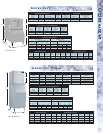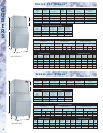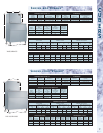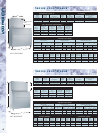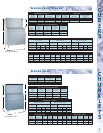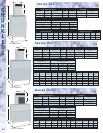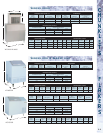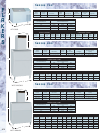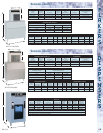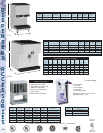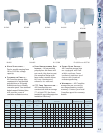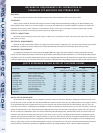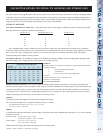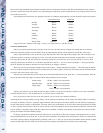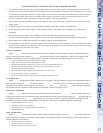
S
P
E
C
I
F
I
C
A
T
I
O
N
G
U
I
D
E
17
The quick reference sizing guide works well in many cases; however, more and more customers’ ice needs are changing. Today’s
customers use ice for numerous applications such as product cooling, self-serve beverages, product packaging, display and, in
some cases, retail package sales. To meet customer needs, a more detailed calculation of ice usage and storage requirements is
required. Listed below are the formulas and guidelines for use in these calculations.
SIZING ICE MACHINES
SELF-SERVE BEVERAGES OR CARRY-OUT
– You need to know the size and quantity of drinks sold. Refer to the following table.
This table assumes the cups are completely filled with ice.
Cup Size (fl.oz.) Average Beverage (fl.oz.) Average Ice (oz.)
63 3
12 6 6
16 8 8
20 10 10
32 16 16
48 24 24
After establishing the number of different sized cups sold in a busy day and multiplying that number by the quantities
indicated, a fairly accurate estimate can be determined. If the establishment uses an ice-cooled beverage dispenser, iced salad
bar or some other type of display that requires ice, the amounts needed are examined separately under the Product
Display/Packing and Coldplate Cooling sections.
COLDPLATE COOLING
– To calculate the amount of ice consumed cooling the coldplate, choose the appropriate operating condi-
tion and multiply by the “average amount of beverage” in the “average cup size.”
EXAMPLE:
Find the amount of ice “burned” on a coldplate for a system that has the following
operating conditions:
1. 80˚F inlet soda/syrup temperature
2. 6 vends/minute
3. 18 fl. oz. average amount of beverage drink
Therefore:
From the table choose row “6” and column “80.”
This gives a constant of 6.8.
6.8 x 18 = 122.4 lbs./hour
PRODUCT DISPLAY/PACKING
– To size an icemaker to handle product display or packing, it is necessary to determine the
cubic feet of ice needed in 24 hours (length x width x depth). Since the calculations are done using the foot as the standard unit
of measure, the depth must be converted into feet. If the depth is less than 12 inches, divide depth required by 12 to make the
conversion to feet. A cubic foot of ice weighs approximately 35 lbs., so multiply the cubic feet of space to be used for product
display or packing by 35 to determine the ice needs for a 24-hour period.
EXAMPLE:
A supermarket has a fish display case that is 25 feet long and 3 feet deep.
They wish to set the fish in ice to a depth of 6 inches (6 inches = .50 foot).
Ice requirement for 24 hours: 25 ft. x 3 ft. x .5 ft. = 37.5 cu.ft.
37.5 cu. ft. x 35 lbs. = 1,312.5 lbs.
SAMPLE:
A restaurant has 200 table seats with 4 turns per night, 20 stools at the bar and a salad bar that measures 6 ft. x 3 ft. with a required
ice depth of 4 inches.
General ice usage: 20 (bar stools) x 3 lbs. = 60 lbs.
200 (seats) x 4 (turns) x 1.5 lbs. = 1,200 lbs.
Product display: 6 ft. x 3 ft. x .33 ft. = 5.94 cu. ft.
5.94 cu. ft. x 35 lbs. = 207.9 lbs.
Finally, add all ice usage to determine the requirement for a 24-hour period:
1,200 lbs. + 60 lbs. + 207.9 lbs. = 1,467.9 lbs. ice per day
Soda/Syrup Inlet Temperature
Drinks
per min. 50 60 70 80 90 100
20.61.11.7 2.3 2.8 3.4
41.12.33.4 4.5 5.6 6.8
61.73.45.1 6.8 8.5 10.2
82.34.56.8 9.0 11.3 13.5
10 2.6 5.6 8.5 11.3 14.1 16.9
12 3.4 6.8 10.2 13.5 16.9 20.3
14 3.9 7.9 11.8 15.8 19.7 23.7
CALCULATION METHOD FOR SIZING ICE MACHINES AND STORAGE BINS



